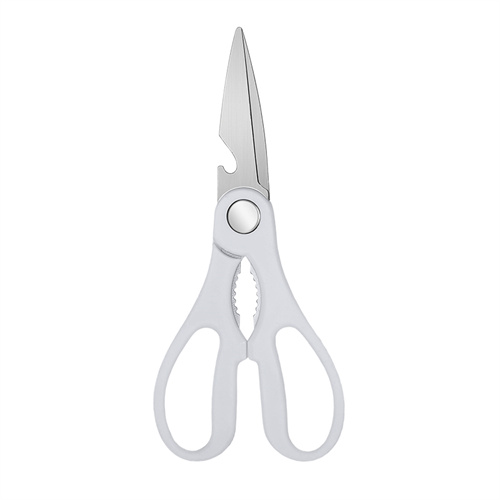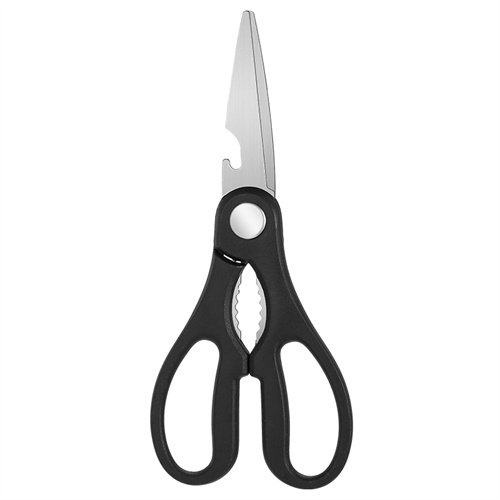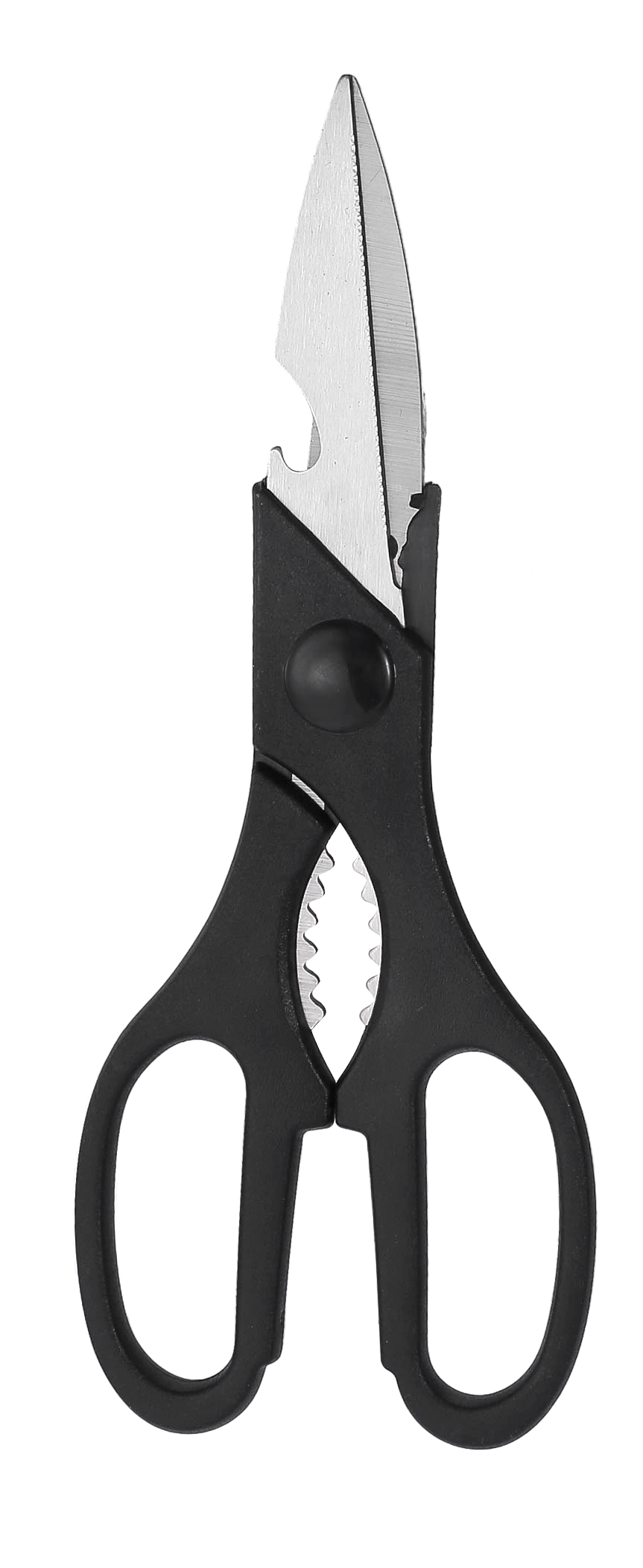

Views: 680 Author: sales@insightknife.com.cn Publish Time: 2025-01-14 Origin: Site








Content Menu
● Understanding Kitchen Shears
● Cleaning Your Kitchen Shears
>> Storing Kitchen Shears Safely
● Frequently Asked Questions regarding Kitchen Shears
>> 1. How often should I clean my kitchen shears?
>> 2. Can I use kitchen shears for cutting raw meat?
>> 3. What is the best way to sharpen kitchen shears?
>> 4. Is it safe to put kitchen shears in the dishwasher?
>> 5. How can I prevent rust on my kitchen shears?
Kitchen shears are an essential tool in any kitchen, providing versatility for various tasks such as cutting herbs, snipping meat, and opening packages. However, like any cutting tool, they require proper maintenance to ensure they remain sharp and functional over time. This article will explore comprehensive long-term maintenance tips for keeping kitchen shears in excellent condition.
Kitchen shears are specialized scissors designed for culinary tasks. They typically feature a sturdy construction, often with stainless steel blades, and may include additional features such as bottle openers or nutcrackers. Their design allows for a comfortable grip and efficient cutting, making them a favorite among home cooks and professional chefs alike. Unlike regular scissors, kitchen shears are built to handle tougher materials, such as poultry skin or thick herbs, making them indispensable in food preparation. Their versatility extends beyond the kitchen, as they can also be used for various household tasks, from opening packages to cutting twine.
Regular maintenance of kitchen shears is crucial for several reasons. Dull blades can lead to inefficient cutting, which may result in uneven food preparation and increased effort. Additionally, poorly maintained shears can harbor bacteria if not cleaned properly, posing a health risk. By investing time in their upkeep, you can extend the lifespan of your shears and ensure they perform optimally. Proper maintenance not only enhances the functionality of the shears but also contributes to a safer cooking environment. Dull or damaged shears can slip or cause accidents, leading to injuries in the kitchen. Therefore, maintaining your kitchen shears is not just about preserving the tool; it’s about ensuring a safe and efficient cooking experience.

After each use, it is essential to clean your kitchen shears to prevent food residue from building up. Here’s how to do it effectively:
Hand Wash: Always hand wash your shears with warm, soapy water. Avoid placing them in the dishwasher, as the high heat and harsh detergents can damage the blades and handles. Hand washing allows for a more thorough clean, ensuring that all food particles are removed.
Use a Soft Cloth: After washing, use a soft cloth or sponge to gently scrub the blades and handles. Pay special attention to the pivot area where food particles can accumulate. This area is often overlooked but is crucial for maintaining the shears' functionality.
Rinse Thoroughly: Ensure all soap is rinsed off to prevent any residue from affecting the taste of your food. Soap residue can impart an unpleasant flavor to food, so thorough rinsing is essential.
Dry Immediately: After rinsing, dry the shears immediately with a clean towel to prevent rusting. Moisture is a significant factor in the deterioration of metal tools. By drying them promptly, you can significantly extend their lifespan.
Occasionally, your kitchen shears may require a more thorough cleaning, especially if they have been used for cutting greasy or sticky foods. For deep cleaning:
Disassemble if Possible: If your shears can be taken apart, do so carefully. This allows you to clean each component thoroughly, ensuring that no food particles are trapped in hard-to-reach areas.
Soak in Soapy Water: Soak the parts in warm, soapy water for a few minutes to loosen any stubborn grime. This step is particularly useful for removing grease and sticky residues.
Scrub with a Brush: Use a small brush, like an old toothbrush, to scrub the blades and handles, ensuring you reach all crevices. A thorough scrubbing will help remove any remaining debris and keep the shears looking new.
Rinse and Dry: Rinse all parts thoroughly and dry them completely before reassembling. Ensuring that all components are dry will help prevent rust and maintain the integrity of the shears.

Keeping your kitchen shears sharp is vital for their performance. Dull blades can make cutting difficult and may even lead to accidents as more force is required to make cuts. A sharp blade not only makes the task easier but also ensures cleaner cuts, which is particularly important when preparing delicate ingredients like herbs or fish. Clean cuts help maintain the integrity of the food, enhancing both presentation and flavor.
Use a Sharpening Stone: A sharpening stone is an effective tool for honing the blades of your shears. Hold the shears at a 20-degree angle against the stone and gently slide the blade across the surface, applying light pressure. This method allows for precise sharpening and can restore the blade's edge effectively.
Honing Rod: For quick touch-ups, a honing rod can be used. Simply run the blade along the rod to realign the edge. This is a great way to maintain sharpness between more thorough sharpening sessions.
Professional Sharpening: If your shears are severely dull or have serrated edges, consider taking them to a professional sharpener. They have the tools and expertise to restore your shears to optimal condition. Professional sharpening can be particularly beneficial for high-quality shears, ensuring they perform at their best.
Lubrication is essential for maintaining the smooth operation of kitchen shears. It helps reduce friction between the blades and prevents rusting. Proper lubrication ensures that the shears open and close smoothly, making them easier to use. Additionally, it protects the metal from moisture and air, which can lead to corrosion over time.
Choose the Right Oil: Use a food-safe mineral oil or a specialized tool lubricant. Avoid using cooking oils, as they can become sticky over time and attract dirt.
Apply Sparingly: Place a few drops of oil on the pivot point of the shears. Open and close the shears several times to distribute the oil evenly. This will ensure that the lubricant penetrates the moving parts effectively.
Wipe Excess Oil: After lubricating, wipe away any excess oil to prevent it from transferring to food during use. Excess oil can create a mess and may affect the taste of your dishes.
How you store your kitchen shears can significantly impact their longevity. Here are some tips for proper storage:
Use a Shear Holder: Invest in a shear holder or magnetic strip that allows you to store your shears safely and accessibly. This prevents them from getting lost or damaged in drawers. A dedicated storage solution also makes it easier to find your shears when you need them.
Avoid Jumbled Drawers: If you must store them in a drawer, ensure they are kept in a protective sheath or wrapped in a cloth to prevent the blades from dulling against other utensils. This will help maintain their sharpness and protect the blades from nicks and scratches.
Keep Away from Moisture: Store your shears in a dry place to prevent rust. Avoid areas near the sink or stove where moisture can accumulate. A dry, cool environment is ideal for preserving the quality of your kitchen tools.
Regularly inspect your kitchen shears for any signs of damage, such as:
Rust: If you notice rust spots, clean them immediately with a rust eraser or fine steel wool, followed by a thorough cleaning and drying. Rust can compromise the integrity of the blades and affect their performance.
Loose Screws: Ensure that the screws holding the blades together are tight. If they are loose, tighten them carefully to maintain the shears' integrity. Loose screws can lead to misalignment, making the shears difficult to use.
Cracks or Chips: Inspect the blades for any cracks or chips. If you find any, it may be time to replace the shears. Damaged blades can pose safety risks and may not perform effectively.
Maintaining kitchen shears is a straightforward process that involves regular cleaning, sharpening, lubrication, and proper storage. By following these long-term maintenance tips, you can ensure that your kitchen shears remain sharp, functional, and safe to use for years to come. Investing a little time in their care will enhance your cooking experience and prolong the life of this essential kitchen tool. A well-maintained pair of kitchen shears not only improves efficiency in the kitchen but also contributes to a more enjoyable cooking experience, allowing you to focus on creating delicious meals.

You should clean your kitchen shears after every use to prevent food residue from building up. Regular cleaning helps maintain hygiene and ensures the shears remain functional.
Yes, kitchen shears are designed to cut through various materials, including raw meat. However, it is essential to clean them thoroughly after use to prevent cross-contamination with other foods.
The best way to sharpen kitchen shears is to use a sharpening stone or a honing rod. For severe dullness or serrated edges, consider taking them to a professional sharpener for optimal results.
No, it is not safe to put kitchen shears in the dishwasher. The high heat and harsh detergents can damage the blades and handles. Hand washing is recommended for proper care.
To prevent rust, always dry your kitchen shears immediately after washing and store them in a dry place. Additionally, applying a few drops of food-safe mineral oil to the pivot point can help protect against moisture and corrosion.
How do the blade materials affect the sharpness retention of kitchen shears over time?
Are There Any Specific Safety Precautions To Consider When Using Kitchen Shears?
Are There Any Specific Safety Precautions To Consider When Using Different Types of Kitchen Shears?
Are There Any Specific Regulations Regarding Kitchen Shear Safety in Professional Kitchens?
What Are Some Safety Tips for Using Kitchen Shears in The Kitchen?
How Do Different Blade Types in Kitchen Shears Affect Cutting Performance?
What Are The Key Differences between Kitchen Shears And Regular Scissors?